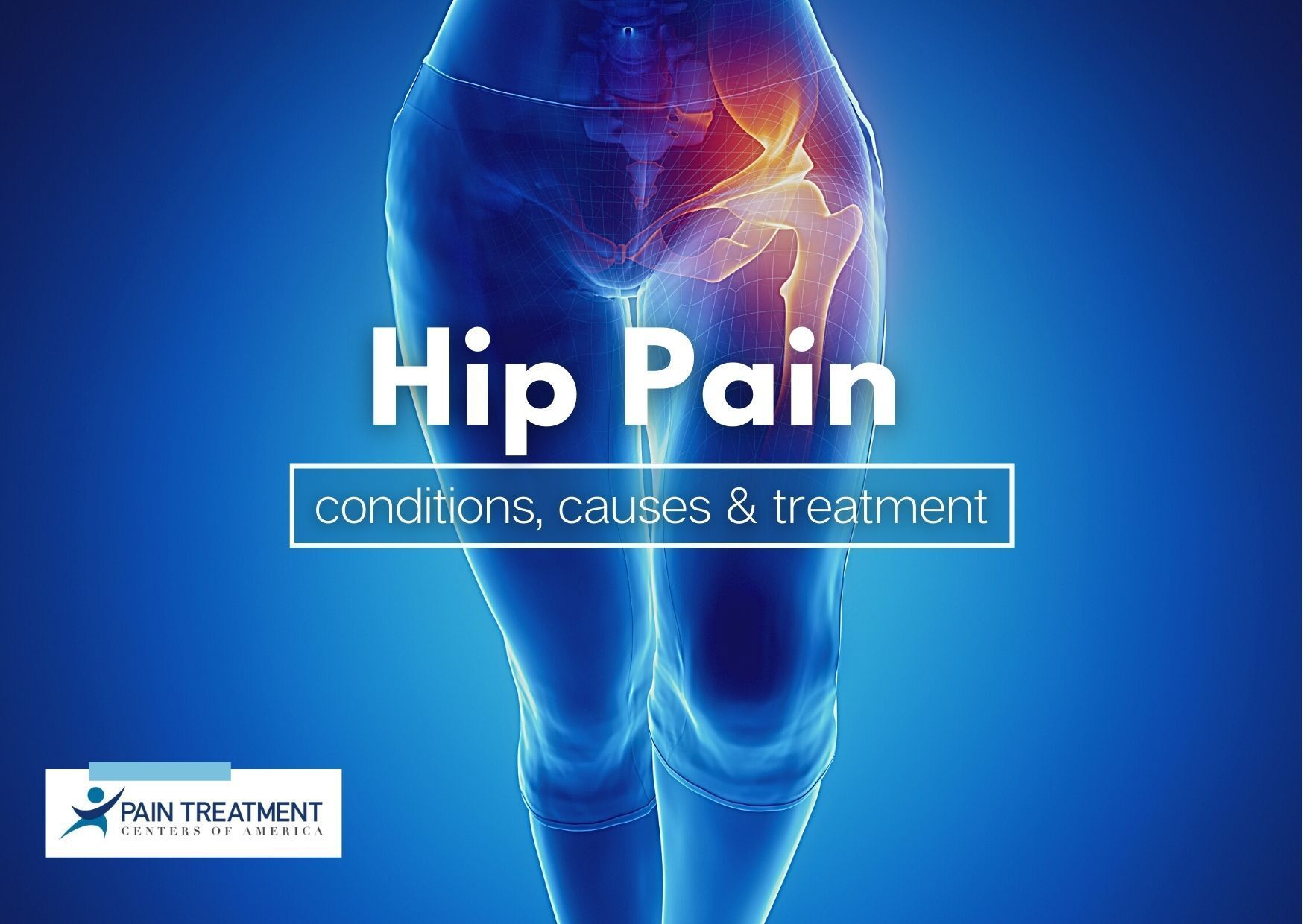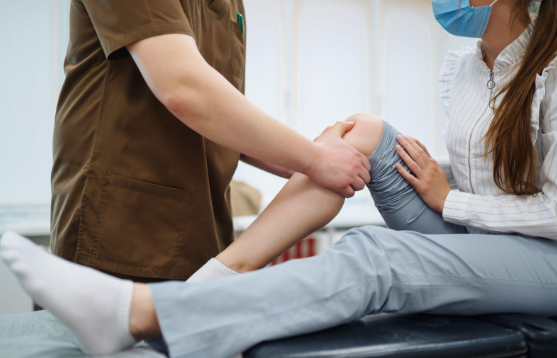An Overview of Hip Pain: Conditions, Causes & Treatment

The hip is a critical joint in the human body. As one of the largest and most dynamic joints, the hip essentially allows our lower bodies to function. The hip performs a dual role—it gives stability to the body by supporting the pelvis and core. Still, it also provides the power and flexibility needed to mobilize our lower extremities.
Having flexible and strong hips is vital for our overall health and mobility. Unfortunately, the hip is a joint that undergoes a large amount of wear and tear, especially as people age, which can cause debilitating pain, discomfort, and loss of mobility.
While hip pain is a common complaint, there are many causes behind it and different treatments. Keep reading to find out the other conditions that can lead to hip pain, both familiar and unique, and how they can be treated.
What Causes Hip Pain?
The hip is a ball and socket joint that allows the thigh to move in different directions. While hip pain can arise from the joint itself, it can also be caused by its structures, such as ligaments and cartilage. Any trauma, infection, chronic condition, or developmental disorder that affects a part of the hip can cause pain.
Traumatic Hip Pain
● Hip Fracture:
Over 300,000 people fracture a hip every year in the United States. The elderly especially are at increased risk of hip fractures due to the thinning of their bones (osteoporosis) and a loss of balance which increases the risk of a fall. Apart from falls, however, hip fractures can be caused by any other form of trauma.
● Contusions:
Also known as bruises, contusions, sprains, and strains can cause hip pain. These injuries are usually caused by trauma to the hip and can be very painful even though the bone is not broken. Sprains are typically due to ligament injuries, while strains happen because of damage to the muscles and tendons.
● Overuse:
Hip pain is very often a result of overuse of the hip joint. The hip joint performs the role of weight-bearing when we walk, jump, or run, and the structures surrounding the joint are meant to shield it from stress. Constant use can cause these muscles, tendons, and ligaments to become inflamed, leading to tendonitis, muscle or tendon strain, or a hip labral tear.
● Hip Bursitis:
Hip bursitis is an inflammation of the bursae, which are tiny, fluid-filled sacs on the outer and inner part of the hip that reduce friction between the moving parts in the joint. Inflammation of the bursa is usually due to mild trauma or overuse and can cause pain that worsens with physical activity.
Non-Traumatic Hip Pain
● Arthritis:
Osteoarthritis and rheumatoid arthritis are both prevalent forms of arthritis, especially in those aged over fifty, and are both known to cause pain in the hip. Apart from these, ankylosing spondylitis and arthritis resulting from inflammatory bowel disease (ulcerative colitis or Crohn’s disease) can also cause hip pain.
● Cancer:
Tumors that either start in the bone or spread to the bone can cause pain in the hips since they weaken the bone, leading to fractures. It also causes swelling and redness over the bone, making movement difficult. Additionally, benign tumors and cysts can also source hip pain.
● Systemic and Autoimmune Diseases:
Some systemic diseases can cause hip pain; for example, sickle cell disease or Lyme disease causes joint swelling, leading to hip pain. Autoimmune conditions like lupus can cause joint inflammation and even arthritis, which can cause hip pain. Viral or bacterial infections can cause both systemic and autoimmune diseases.
● Avascular Necrosis:
Avascular necrosis occurs when a localized part of the bone becomes dead due to loss of blood supply. It is usually a result of trauma to the area, disease, or a side effect of a prolonged medication like prednisone. Although avascular necrosis is slightly less common than the other causes of hip pain, the hip is the joint most frequently affected by this condition.
● Fibromyalgia:
Fibromyalgia is a systemic disease that causes chronic pain in the muscles and ligaments. Around 4 million people in the U.S. suffer from fibromyalgia. The pain and stiffness caused by it can manifest as hip pain and tenderness, especially in the mornings.
● Referred Pain:
Referred pain is when another part of the body causes pain in one part of the body. Some conditions that can cause referred pain include hernias, peripheral nerves, and sciatica.
What Are the Symptoms That Come with Hip Pain?
Symptoms of hip pain can change depending on which condition is causing the pain, but most people often have a hard time describing symptoms past the pain they experience. Below are some of the common symptoms people face from hip problems and the symptoms caused by specific conditions.
Common Symptoms
● Limping.
● Stiffness in the hip joint.
● Referred pain (can be felt in the knee or leg).
● Muscle stiffness.
● Pain in the leg when weight is applied.
Symptoms for Specific Conditions
- Fracture. Hip fractures usually cause an immediate onset of acute pain that worsens when movement in the area. There may be visible displacement in the joint or leg. If the fracture is in the pelvis, there will be no noticeable displacement, but the pain will increase with movement and weight-bearing.
2. Overuse. Overuse injuries may not have immediate pain but pain that steadily worsens over the following minutes or hours. As the muscles around the joint spasm or become inflamed, the pain will worsen, causing swelling, limping, reduced movement, and a clicking or locking sensation in the hip.
3. Bone Cancer. Cancer in the bone can cause intense and constant pain, regardless of whether it originated or spread there from another part of the body. It usually does not become better or worse with rest or movement. The pain may also radiate outwards from the location into neighboring body areas.
4. Sciatica. This pain tends to originate from the lower back and slowly radiates down to the front or back of the hip. Sciatica pain can present differently in different people but is often described as a sharp, stabbing, or burning pain. The pain can increase when the knee is straightened by stretching the sciatica nerve. There may also be numbing or tingling in the leg or foot.
5. Arthritis. Inflammatory arthritis of the hip can cause dull pain in the hip, groin, outer thigh, knee, and buttocks. Arthritis pain increases after periods of inactivity, such as after sleeping or sitting for a while, but it can also grow with vigorous activity. The pain and stiffness can become severe enough to cause limping and make walking difficult.
How Are Hip Conditions Treated?
Treatments for hip pain depend on the condition and the underlying cause of the pain.
● OTC Medication. Over-the-counter pain medications do not require a prescription from a medical professional. Still, they must be taken with caution as they can cause side effects or interact poorly with prescription medications. Older people should ask a healthcare professional for advice before taking OTC medication.
● Walking Aids. Crutches, a cane, or a walker are common walking aids that help people struggling to walk normally. However, they will need to be fitted to the patient’s height, and some people might require training to use them properly. They are also a short-term solution as the cause of the pain will still have to be treated.
● Exercise. An exercise program that focuses on stretching and strengthening the leg, hip, and back can help recover and improve range of motion. However, any exercise should be coordinated with a medical professional to avoid further injury.
● Prescription Medication. Prescription medication is usually given to treat the underlying cause of the hip pain rather than the pain itself. Rheumatoid arthritis, for example, can be treated with prescription medications.
● Surgery. Surgery is a standard treatment option for hip fractures. Hip replacement surgery is also one of the most common joint replacement surgeries, especially in patients with progressive arthritis. Hip arthroscopy is also used to evaluate and treat joint damage, cartilage tears, and early arthritis.
How Can Pain Treatment Centers of America Help?
With eleven pain treatment clinics across America and state-of-the-art pain management solutions, Pain Treatment Centers of America provides you with comprehensive solutions for your hip pain. We offer the following treatments for hip pain:
● Nerve Block
● Radiofrequency Ablation
● Trigger Point Injections
● Medical Management
Pain Treatment Centers of America have the most combined pain management experience of any practice within the region with experts from multiple medical specialties, CLIA-certified labs, cutting-edge surgery centers, and more. To learn more about how we can help you find relief from hip pain, call us at (844) 215-0731, or visit our website today.













